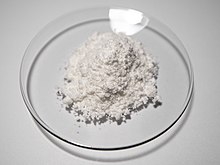
| |
 Sample of pure compound | |
| Names | |
|---|---|
| Preferred IUPAC name Bis(2,4,6-trichlorophenyl) oxalate | |
| Other names Bis(2,4,6-trichlorophenyl) ethanedioate; Oxalic acid, bis(2,4,6-trichlorophenyl) ester | |
| Identifiers | |
| CAS Number | |
| 3D model (JSmol) | |
| ChemSpider | |
| ECHA InfoCard | 100.157.526 |
| PubChem CID | |
| CompTox Dashboard (EPA) | |
InChI
| |
SMILES
| |
| Properties | |
| Chemical formula | C14H4Cl6O4 |
| Molar mass | 448.88 g·mol |
| Appearance | White crystalline powder |
| Density | 1.698 g/cm |
| Melting point | 188 to 192 °C (370 to 378 °F; 461 to 465 K) |
| Boiling point | 500.9 °C (933.6 °F; 774.0 K) |
| Solubility in water | 0.01962 mg/L |
| Hazards | |
| Flash point | 190.6 °C (375.1 °F; 463.8 K) |
| Except where otherwise noted, data are given for materials in their standard state (at 25 °C , 100 kPa). Infobox references | |
TCPO, or bis(2,4,6-trichlorophenyl) oxalate, is a chemical used in some types of glow sticks and is a key chemical in many chemiluminescent reactions. TCPO is classified as damaging to human organs and toxic if inhaled with an inhalable toxicity of 3.02 mg/L and oral toxicity LD50 of 820 mg/kg (rat). Additionally, TCPO is considered a danger to drinking water if even small quantities leak into the ground, and if spilled it is recommended to soak up with wood chips or absorbent material then disposing of as hazardous waste.
Uses
When combined with a fluorescent dye like 9,10-bis(phenylethynyl)anthracene, a solvent (such as diethyl phthalate), and a weak base (usually sodium acetate or sodium salicylate), and hydrogen peroxide, the mixture will start a chemiluminescent reaction to glow a fluorescent green color.
Red, yellow and blue colors can be made by replacing the 9,10-bis(phenylethynyl)anthracene with rhodamine B, rubrene and 9,10-diphenylanthracene respectively.
The above fluorescent dyes absorb much of the energy produced during the decomposition of the oxalate ester, and convert that energy into light energy which is observed as the characteristic glow in products such as glowsticks.
Preparation
TCPO can be prepared from a solution of 2,4,6-trichlorophenol in a solution of dry toluene by reaction with oxalyl chloride in the presence of a base such as triethylamine. This method produces crude TCPO with a by-product of triethylamine hydrochloride. The triethylamine hydrochloride can be dissolved in water, methanol or ethanol, so the product is more purified. After washing it can be recrystallized from ethyl acetate.
Safety and Recommendations
Human Safety Recommendations
Use only outdoors or in a well-ventilated area. Wear protective gloves/protective clothing/eye protection/face protection.
If on skin (or hair): Take off immediately all contaminated clothing. Rinse skin with water/shower. Call a POISON CENTER or doctor/physician.
If Inhaled : Remove person to fresh air and keep comfortable for breathing.Call a POISON CENTER or doctor/physician. In case of unconsciousness place patient stably in side position for transportation.
Environmental Safety and Waste Management Recommendations
Must not be disposed of together with household garbage. Do not allow product to reach sewage system. Disposal must be made according to official regulations. : Do not allow to enter sewers/ surface or ground water. If there is a spill, it is recommended to absorb with liquid-binding material (sand, diatomite, acid binders, universal binders, sawdust) then dispose of as 'hazardous waste'.
See also
- Bis(2,4,5-trichlorophenyl-6-carbopentoxyphenyl)oxalate (CPPO)
- MCPO
- Trichlorophenol
- 2,4,5-Trichlorophenol
References
- https://www.agilent.com/cs/library/msds/EPA-1162-1_NAEnglish.pdf
- Mohan, Arthur G.; Turro, Nicholas J. (August 1974). "A Facile and Effective Chemiluminescence Demonstration Experiment". Journal of Chemical Education. 51 (8): 528. Bibcode:1974JChEd..51..528M. doi:10.1021/ed051p528.